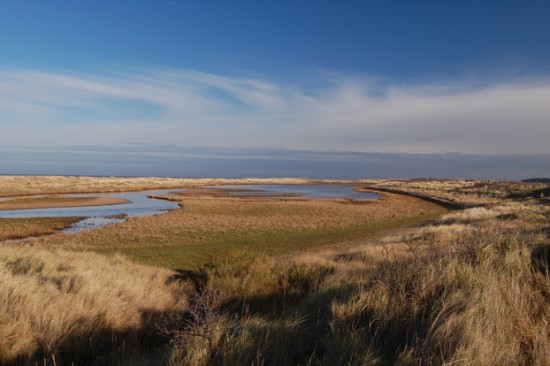By Danny Adcock.
Can a place have soul? We could probably spend several hours discussing what soul is, or even if there is such a thing as soul – other than the Stevie Wonder or Gil Scott Heron type that is – never mind whether a place can have soul or not. You can’t deny that there are some places that have a certain feel; an atmosphere; a very discernible something. So why not call it soul? I’m not sure there’s any other label or term you could put on it, but I’m equally sure it exists.
For me, the north Norfolk coast has got soul; it’s got soul in abundance. There’s soul in the deep rolling dunes of the beaches: from Holme, to Burnham Overy Staithe, Holkham bay, and Wells. In summer these beaches ring with the cries of children, and the joyful barking of the family dog with miles and miles of pillow-soft sand to play and run in. There’s so much room here though the beaches are never crowded; you can always find a quiet dune and a clump of marram grass to shield you even in the height of the tourist season. The numerous fishing villages that line the coast here are flinty jumbles of cottages, usually with a couple of decent, even outstanding, pubs, and a harbour hidden down a quiet lane.
There’s soul to be heard in the chalk streams that run through the rolling farmland behind the coast, and wind their way to the sea through the marshes – the Glaven, the Stiffkey, the Burn. These rivers are closely guarded secrets, as are chalk streams everywhere; there are opportunities to fish for their wild brown trout, and even odd sea trout, but they are few and far between.
Norfolk has a sense of history in the strangest of places: on Holme beach at low tide you can wander amongst a blackened, peat-preserved, four thousand year old forest. A decade ago a remarkable structure was revealed here as, wave by wave, a wooden circle of 52 tree trunks surrounding an upturned oak stump was discovered. It was named Seahenge, excavated between tides, and can now be viewed in King’s Lynn museum. On Holme beach now you can still find trees, roots and bark intact, half buried in the peat that has preserved them for the last four thousand years.
However, it’s in winter when north Norfolk’s soul really begins to move me. Famously, if you head north from the coast here, there’s no landfall until you reach the Arctic; sometimes it can seem as if the wind has just arrived, scything across the vast beaches, sweeping the sand into a million face-stinging particles. There’s something primal about the beaches and marshes in winter that you can hear in the voices of the waders across the wind: oyster-catchers, and redshanks with their pinging alarm calls resonating from the tideline.
Sometimes, lying in bed on a moonlit night, a sound reaches me – thanks to the rather drafty double-glazing – deep in my dreams. It’s an elemental call from a bird that epitomises the sense of wild, free nature you can find along this, and many other coasts. Upwards of forty thousand pinkfooted geese make their way over my house, between the sanctuary of the coastal marshes and mudflats, and their feeding grounds inland. Some evenings I can stand staring skyward while skein after skein, line after line of geese, literally fill the skies; they can take up to an hour to pass over. They leave me with an abiding sense of being tied to the earth. These great wanderers will be soon be gone: migrating back north to the tundra, and though there are other things to look forward to – the arrival of the sea-bass in spring, the start of the fly- and coarse fishing seasons – I’ll be here still, waiting for the soul of winter to return and the wild geese to come calling again.
